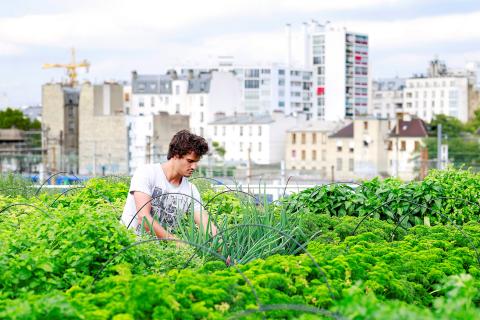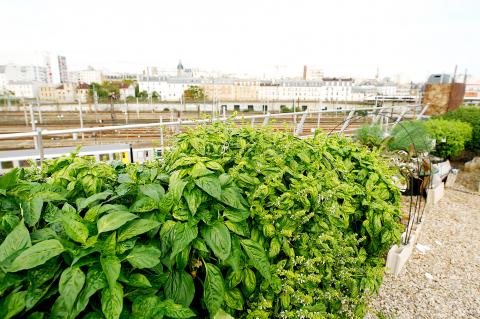At the top of a three-storey building in Hong Kong, with car horns blasting on the streets below, Jim Fung teaches a dozen students how to thin out choi sum vegetables.
“Always use the resources you have,” the instructor said as he placed shredded office paper into soil-filled plastic crates and wound string around bamboo sticks to make support frames.
Fung was coaching the first cohort of students in an academy run by social enterprise Rooftop Republic to teach a new generation of urban farmers as demand for their skills soars.

Photo: AFP
The organization is spearheading a movement to turn Hong Kong’s idle rooftops and urban spaces into farms to help residents reconnect with nature and make the finance hub more liveable.
Once a cluster of fishing and farming villages, Hong Kong is now one of the most densely packed cities on Earth, with 7.4 million people living on a quarter of its 1,100 square km of land.
The rest is mainly country parks and rural areas, but living in skyscrapers and working long hours has caused Hong Kongers to lose touch with the nature around them, say students at the academy.

Photo: AFP
“We’ve become detached from the history of the sea and land that Hong Kong had,” said Jessica Cheng, a Rooftop Republic student who works for a philanthropic organization.
Andrew Tsui, one of Rooftop Republic’s three co-founders, said he wants the academy to be “Le Cordon Bleu” (a famous cookery school) of urban farming.
To him, that means a place where graduates become masters of the practice and at the same time become “stewards of our planet, our wellbeing, and our communities,” he said.
Founded in 2015, Rooftop Republic has set up more than 50 urban farms so far.
It launched its academy in March, starting with events and workshops. The organization’s first urban farming course, which began last month, teaches students botany, organic farming and how to manage soil, pests, weeds and water resources.
Their classroom sits atop the headquarters of Hong Kong’s Business Environment Council, a non-profit promoting sustainability in the world’s second most-expensive city for property after Monaco, according to global realtor Knight Frank.
Since 2008 more than 60 rooftop farms have sprouted up around Hong Kong, covering 15,000 square metres, said Mathew Pryor, who heads the University of Hong Kong’s landscape architecture division.
He estimates another six square km of rooftop space could be available — about half the size of Hong Kong’s airport and just less than the seven square km of agricultural land in the city.
Hoping to expand that potential, Tsui said that Rooftop Republic has been working with developers to include rooftop farms in their design blueprints.
One day, he predicted, rooftop farmers will be as necessary as facility managers who look after clubhouses and pools.
His organization will train about 150 urban farmers over the next year, he added.
“We have the power to shape the future city we live in ... through demonstrating how adopting an urban farm lifestyle helps the end consumer become aware of ecology, biodiversity, nature, wellbeing and a circular food system,” Tsui said.
SOCIAL VALUE
In the 1,200-square-metre Sky Garden in Metroplaza Mall — the largest urban farm atop a retail mall in Hong Kong — residents can cultivate edible flowers and fruit trees as they attend lifestyle classes like mindful gardening.
Research by ecological and agricultural experts shows rooftop farms not only produce food, but also create green spaces and boost biodiversity.
They also help mitigate the so-called “heat island” effect in cities, when heat is trapped by dark-colored roads and buildings.
Just as importantly, Tsui said, the farms build communities among the people who care for the crops.
“There is huge potential for rooftop farming in a high-density city,” said Pryor, the landscape architecture expert.
“Particularly if it can be aligned with social issues, like aging-in-place,” he added, referring to when people have the chance to grow old in their own homes.
Access to a nearby rooftop farm can help the elderly engage with their community and keep them in good mental and physical health, he explained.
In a study of 108 people using rooftop farms, Pryor found more than three-quarters of respondents said they saw social value as the most important benefit of working on the farms, with socialising topping the list.
They added it was good for their health and for learning about nature.
Such learning is key, said academy student Alyson Hamilton, a teacher who runs her school’s micro-garden.
“(My) students have no knowledge about food, where it comes from, how much plastic it comes in,” she lamented.
NATURE AND COMMUNITY
Alongside the high cost and scarcity of space in Hong Kong, the main challenge for budding urban farmers is having the right conditions, Tsui said.
The basics that plants need — natural sunlight, fresh water and fresh air — are often in short supply in the city, he added.
“Our big question is, if many of our city spaces are not suitable for plants to survive, then how are they conducive for human beings?” he asked.
With more than half the world’s population living in cities, Tsui said he’s using what he has learnt from rooftop farming to engage urban planners and shape a human-centric city.
He questions whether the move toward so-called “smart cities” around the world actually allows city-goers to live smarter.
“Are we smarter in getting closer to nature for our wellbeing? Are we smarter in the way we design our neighborhoods, allowing access to fresh air, direct sunlight and nature?” he asked.
Working with architects, planners and developers allows Rooftop Republic to incorporate some of those factors into the blueprints for new developments.
But rooftop farms — which are legal in Hong Kong — currently exist in a grey area between formal city planning and informal community action, said Pryor, the landscape architecture professor.
Both the city’s New Agricultural Policy paper, published in 2014, and the Hong Kong 2030+ strategic plan acknowledged rooftop farms as playing a significant part in urban agriculture. Government officials did not respond to interview requests.
Pryor would like to see the city’s government include such farms into mainstream building and land policy, in recognition of how important they are for creating sustainable cities.
Tsui agreed, saying urban planners need to create ecosystems to nurture people’s connection to nature.
“We want to put nature and community back into where we play, where we work, where we live,” he said.

May 18 to May 24 Pastor Yang Hsu’s (楊煦) congregation was shocked upon seeing the land he chose to build his orphanage. It was surrounded by mountains on three sides, and the only way to access it was to cross a river by foot. The soil was poor due to runoff, and large rocks strewn across the plot prevented much from growing. In addition, there was no running water or electricity. But it was all Yang could afford. He and his Indigenous Atayal wife Lin Feng-ying (林鳳英) had already been caring for 24 orphans in their home, and they were in

President William Lai (賴清德) yesterday delivered an address marking the first anniversary of his presidency. In the speech, Lai affirmed Taiwan’s global role in technology, trade and security. He announced economic and national security initiatives, and emphasized democratic values and cross-party cooperation. The following is the full text of his speech: Yesterday, outside of Beida Elementary School in New Taipei City’s Sanxia District (三峽), there was a major traffic accident that, sadly, claimed several lives and resulted in multiple injuries. The Executive Yuan immediately formed a task force, and last night I personally visited the victims in hospital. Central government agencies and the

Australia’s ABC last week published a piece on the recall campaign. The article emphasized the divisions in Taiwanese society and blamed the recall for worsening them. It quotes a supporter of the Taiwan People’s Party (TPP) as saying “I’m 43 years old, born and raised here, and I’ve never seen the country this divided in my entire life.” Apparently, as an adult, she slept through the post-election violence in 2000 and 2004 by the Chinese Nationalist Party (KMT), the veiled coup threats by the military when Chen Shui-bian (陳水扁) became president, the 2006 Red Shirt protests against him ginned up by

As with most of northern Thailand’s Chinese Nationalist Party (KMT) settlements, the village of Arunothai was only given a Thai name once the Thai government began in the 1970s to assert control over the border region and initiate a decades-long process of political integration. The village’s original name, bestowed by its Yunnanese founders when they first settled the valley in the late 1960s, was a Chinese name, Dagudi (大谷地), which literally translates as “a place for threshing rice.” At that time, these village founders did not know how permanent their settlement would be. Most of Arunothai’s first generation were soldiers